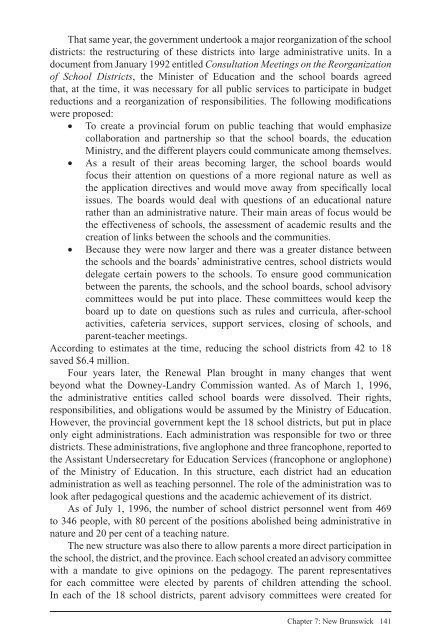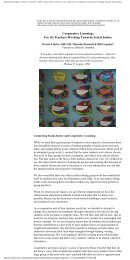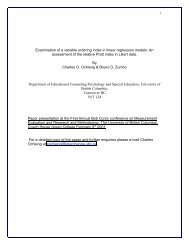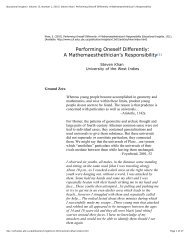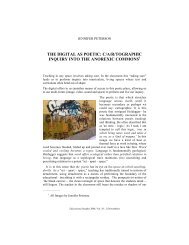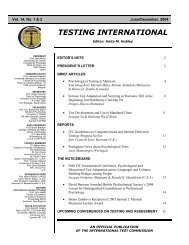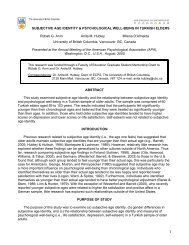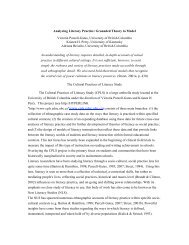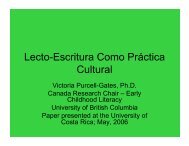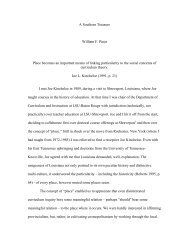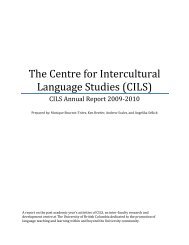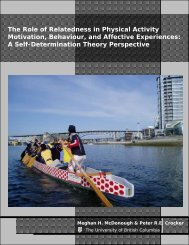The evolution of professionalism - Centre for Policy Studies in ...
The evolution of professionalism - Centre for Policy Studies in ...
The evolution of professionalism - Centre for Policy Studies in ...
Create successful ePaper yourself
Turn your PDF publications into a flip-book with our unique Google optimized e-Paper software.
That same year, the government undertook a major reorganization <strong>of</strong> the school<br />
districts: the restructur<strong>in</strong>g <strong>of</strong> these districts <strong>in</strong>to large adm<strong>in</strong>istrative units. In a<br />
document from January 1992 entitled Consultation Meet<strong>in</strong>gs on the Reorganization<br />
<strong>of</strong> School Districts, the M<strong>in</strong>ister <strong>of</strong> Education and the school boards agreed<br />
that, at the time, it was necessary <strong>for</strong> all public services to participate <strong>in</strong> budget<br />
reductions and a reorganization <strong>of</strong> responsibilities. <strong>The</strong> follow<strong>in</strong>g modifi cations<br />
were proposed:<br />
• To create a prov<strong>in</strong>cial <strong>for</strong>um on public teach<strong>in</strong>g that would emphasize<br />
collaboration and partnership so that the school boards, the education<br />
M<strong>in</strong>istry, and the different players could communicate among themselves.<br />
• As a result <strong>of</strong> their areas becom<strong>in</strong>g larger, the school boards would<br />
focus their attention on questions <strong>of</strong> a more regional nature as well as<br />
the application directives and would move away from specifi cally local<br />
issues. <strong>The</strong> boards would deal with questions <strong>of</strong> an educational nature<br />
rather than an adm<strong>in</strong>istrative nature. <strong>The</strong>ir ma<strong>in</strong> areas <strong>of</strong> focus would be<br />
the effectiveness <strong>of</strong> schools, the assessment <strong>of</strong> academic results and the<br />
creation <strong>of</strong> l<strong>in</strong>ks between the schools and the communities.<br />
• Because they were now larger and there was a greater distance between<br />
the schools and the boards’ adm<strong>in</strong>istrative centres, school districts would<br />
delegate certa<strong>in</strong> powers to the schools. To ensure good communication<br />
between the parents, the schools, and the school boards, school advisory<br />
committees would be put <strong>in</strong>to place. <strong>The</strong>se committees would keep the<br />
board up to date on questions such as rules and curricula, after-school<br />
activities, cafeteria services, support services, clos<strong>in</strong>g <strong>of</strong> schools, and<br />
parent-teacher meet<strong>in</strong>gs.<br />
Accord<strong>in</strong>g to estimates at the time, reduc<strong>in</strong>g the school districts from 42 to 18<br />
saved $6.4 million.<br />
Four years later, the Renewal Plan brought <strong>in</strong> many changes that went<br />
beyond what the Downey-Landry Commission wanted. As <strong>of</strong> March 1, 1996,<br />
the adm<strong>in</strong>istrative entities called school boards were dissolved. <strong>The</strong>ir rights,<br />
responsibilities, and obligations would be assumed by the M<strong>in</strong>istry <strong>of</strong> Education.<br />
However, the prov<strong>in</strong>cial government kept the 18 school districts, but put <strong>in</strong> place<br />
only eight adm<strong>in</strong>istrations. Each adm<strong>in</strong>istration was responsible <strong>for</strong> two or three<br />
districts. <strong>The</strong>se adm<strong>in</strong>istrations, fi ve anglophone and three francophone, reported to<br />
the Assistant Undersecretary <strong>for</strong> Education Services (francophone or anglophone)<br />
<strong>of</strong> the M<strong>in</strong>istry <strong>of</strong> Education. In this structure, each district had an education<br />
adm<strong>in</strong>istration as well as teach<strong>in</strong>g personnel. <strong>The</strong> role <strong>of</strong> the adm<strong>in</strong>istration was to<br />
look after pedagogical questions and the academic achievement <strong>of</strong> its district.<br />
As <strong>of</strong> July 1, 1996, the number <strong>of</strong> school district personnel went from 469<br />
to 346 people, with 80 percent <strong>of</strong> the positions abolished be<strong>in</strong>g adm<strong>in</strong>istrative <strong>in</strong><br />
nature and 20 per cent <strong>of</strong> a teach<strong>in</strong>g nature.<br />
<strong>The</strong> new structure was also there to allow parents a more direct participation <strong>in</strong><br />
the school, the district, and the prov<strong>in</strong>ce. Each school created an advisory committee<br />
with a mandate to give op<strong>in</strong>ions on the pedagogy. <strong>The</strong> parent representatives<br />
<strong>for</strong> each committee were elected by parents <strong>of</strong> children attend<strong>in</strong>g the school.<br />
In each <strong>of</strong> the 18 school districts, parent advisory committees were created <strong>for</strong><br />
Chapter 7: New Brunswick 141


